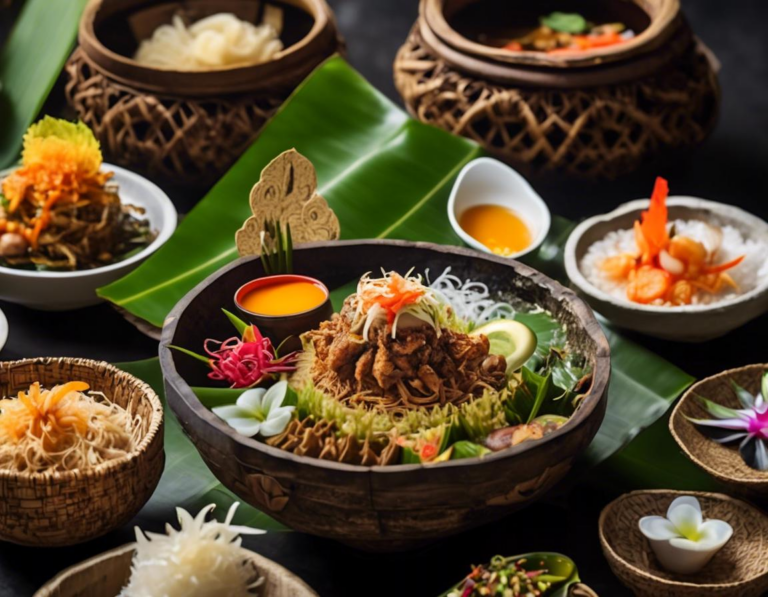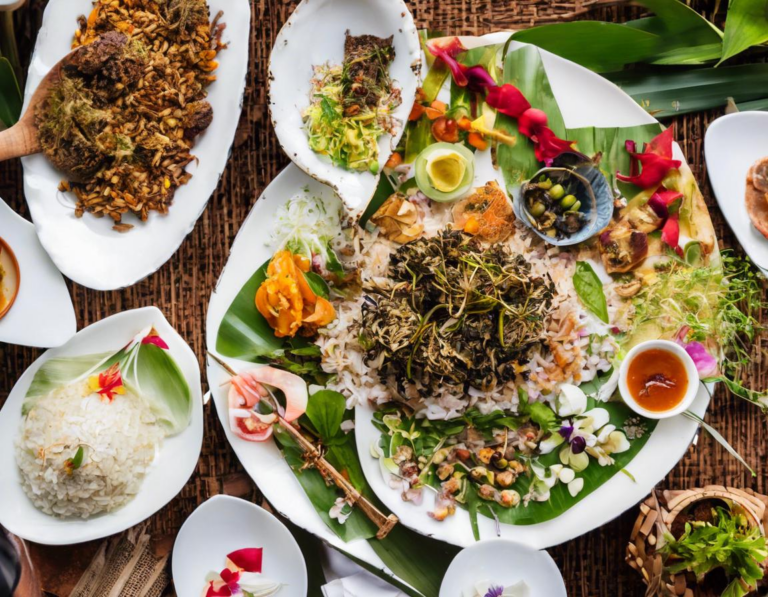Bali, the “Island of Gods,” is renowned for its stunning natural beauty, vibrant culture, and, of course, its delectable cuisine. Makanan khas Bali offers a tantalizing blend of flavors, aromas, and textures that will leave your taste buds singing. Whether you’re a seasoned foodie or a curious traveler, exploring the culinary delights of Bali is an absolute must.
The Essence of Balinese Cuisine: A Symphony of Flavors

Balinese cuisine is a reflection of the island’s rich heritage and diverse influences. The food is characterized by its use of fresh, local ingredients, fragrant spices, and a harmonious balance of flavors. From spicy curries to savory satays, sweet desserts, and refreshing drinks, each dish tells a story of Balinese culture and tradition.
Key ingredients that define Balinese cuisine include:
- Coconut: A staple ingredient used in curries, sauces, and desserts.
- Lemongrass: Adds a distinctive aroma and flavor to many dishes.
- Galangal: A ginger-like root that provides a subtle, peppery flavor.
- Turmeric: A vibrant yellow spice that adds color and a slightly earthy flavor.
- Chili peppers: Used liberally to create a spicy kick.
- Shrimp paste: Adds a savory umami flavor to many dishes.
- Sea salt: Often used to enhance the flavors of food.
Must-Try Makanan Khas Bali: A Culinary Journey

Bali offers a diverse range of delicious dishes that will satisfy every palate. Let’s embark on a culinary journey and discover some of the most popular and must-try Makanan Khas Bali:
1. Babi Guling: A Must-Have Balinese Delicacy
Babi guling, meaning “roasted pig,” is arguably the most iconic dish in Bali. This dish features a whole pig marinated in a blend of turmeric, garlic, ginger, and other spices, then roasted to perfection over charcoal. The result is succulent, crispy-skinned pork with a rich, flavorful marinade. The dish is typically served with lawar, a savory mixture of minced pork, vegetables, and spices, and satai lilit, grilled satay made with minced meat wrapped around lemongrass stalks.
2. Sate Lembar: Grilled Goodness with a Unique Twist
Sate lembar is a popular street food that features thin slices of marinated meat grilled to perfection. The meat is typically beef or chicken, marinated in a blend of soy sauce, garlic, ginger, and spices, and then grilled over charcoal. What makes sate lembar unique is that the meat is grilled on a thin, flat skewer made from coconut leaves. This creates a unique smoky flavor and adds a touch of rustic charm to the dish.
3. Lawar: Savory Balinese Delicacy with a Twist
Lawar is a traditional Balinese dish that features a unique combination of ingredients. It is made with minced meat (pork, chicken, or beef), vegetables, and spices, and it can be either cooked or raw. The most popular type of lawar is lawar putih, which is made with minced pork and turmeric, while lawar merah contains minced pork and chili peppers. Lawar is often served as a side dish with nasi campur, a mixed rice dish, or as part of a larger meal.
4. Nasi Campur: A Feast for Your Senses
Nasi campur is a beloved Balinese dish that features a combination of rice, vegetables, meat, and various sauces. It is a perfect example of the balance of flavors and textures that define Balinese cuisine. A typical nasi campur will include steamed rice, satai, lawar, sambal, tempe, and vegetables. The dish is often served with a dollop of “kicap manis,” a sweet soy sauce that adds a touch of sweetness to the dish.
5. Jimbaran Seafood: Freshly Grilled Seafood with a View
If you’re a seafood lover, then you must try Jimbaran seafood. This dish features a variety of fresh seafood, including fish, prawns, squid, and shellfish, grilled to perfection over charcoal. The seafood is typically marinated in a blend of spices, including turmeric, garlic, and ginger, and then grilled to perfection. The best place to enjoy Jimbaran seafood is on the beach at sunset, where you can enjoy the stunning views of the ocean while savoring the delicious food.
6. Ayam Betutu: A Spicy and Aromatic Delight
Ayam betutu is a traditional Balinese dish that features a whole chicken marinated in a blend of spices, including turmeric, ginger, garlic, lemongrass, and chili peppers. The chicken is then wrapped in banana leaves and steamed or roasted until tender. Ayam betutu is known for its rich, aromatic flavors and spicy kick. The dish is typically served with nasi campur, a mixed rice dish, or as part of a larger meal.
7. Sate Plecing: A Tangy and Spicy Treat
Sate plecing is a popular Balinese dish that features skewers of grilled meat, typically chicken or beef, served with a tangy and spicy sauce. The meat is marinated in a blend of soy sauce, garlic, ginger, and spices, then grilled over charcoal. The sauce is made with a mixture of lemons, chili peppers, and shallots, creating a spicy and tangy flavor that complements the grilled meat perfectly.
8. Babi Kecap: Savory Pork with a Sweet Twist
Babi kecap is a traditional Balinese dish that features pork cooked in a rich, savory sauce made with soy sauce, sugar, garlic, ginger, and spices. The pork is typically braised or simmered in the sauce until tender, creating a dish that is both flavorful and comforting. Babi kecap is often served with rice and vegetables, and it is a popular choice for lunch or dinner.
9. Sup Buntut: A Hearty and Aromatic Soup
Sup buntut, meaning “oxtail soup,” is a popular Balinese dish that features a rich and aromatic broth made with oxtail, vegetables, and spices. The oxtail is cooked until tender, creating a flavorful and hearty broth. Sup buntut is often served with rice and a side of vegetables.
10. Bubuh Injin: Sweet and Savory Rice Pudding
Bubuh injin is a traditional Balinese dessert made with rice flour, coconut milk, and sugar. The rice flour is cooked in coconut milk until thick and creamy, then flavored with sugar and spices. Bubuh injin is often served warm and topped with grated coconut or a drizzle of honey.
11. Jaje Batun Bedil: A Sweet and Chewy Delight
Jaje batun bedil is a popular Balinese snack made with glutinous rice flour, coconut milk, and sugar. The flour is cooked in coconut milk until thick and sticky, then molded into small, round balls. Jaje batun bedil is often served with a sweet sauce made with sugar and coconut milk.
12. Es Cendol: A Refreshing and Sweet Treat
Es cendol is a popular Balinese dessert made with green rice flour noodles, coconut milk, sugar, and ice. The noodles are cooked in coconut milk until soft and chewy, then served with a sweet syrup and a scoop of ice. Es cendol is a refreshing and sweet treat that is perfect for a hot day.
Finding Makanan Khas Bali: Where to Eat and What to Expect

Bali has a wealth of restaurants and street food stalls where you can indulge in the island’s culinary delights. Here are some places to explore:
- Warung: These small, family-run eateries offer a taste of authentic Balinese cuisine at affordable prices.
- Street food stalls: You’ll find an abundance of delicious and affordable street food in Bali, from satay and grilled meats to rice dishes and desserts.
- Fine dining restaurants: For a more upscale dining experience, Bali has a number of fine dining restaurants that offer contemporary Balinese cuisine with a modern twist.
Here are some things to keep in mind when ordering makanan khas Bali:
- Spice levels: Balinese food can be quite spicy, so it’s best to ask for your food to be prepared to your desired spice level.
- Portions: Portions tend to be generous, so you might want to share a few dishes with your dining companions.
- Etiquette: It’s considered polite to eat with your right hand in Bali, and to use a fork and spoon for scooping food.
- Dining style: In Bali, it’s common to eat with your hands, so don’t be afraid to try it if you’re feeling adventurous!
Beyond the Plate: Culinary Experiences in Bali

Beyond the delicious food, Bali offers a number of unique culinary experiences:
- Cooking classes: Immerse yourself in Balinese cuisine by taking a cooking class, where you can learn how to prepare some of the island’s most iconic dishes.
- Food tours: Join a food tour to discover the hidden gems of Balinese cuisine and try dishes that you might not find on menus.
- Local markets: Visit a local market to experience the vibrant atmosphere and taste fresh produce, spices, and other culinary delights.
- Festivals: Attend a local festival to experience the vibrant culture and traditions of Bali, including the delicious food that is often served.
Embark on Your Culinary Adventure in Bali
Bali’s cuisine is a testament to the island’s rich culture, history, and traditions. From spicy curries to savory satays, sweet desserts, and refreshing drinks, there is something for everyone to enjoy. So, next time you visit Bali, be sure to indulge in the island’s culinary delights and experience the magic of Makanan Khas Bali.





